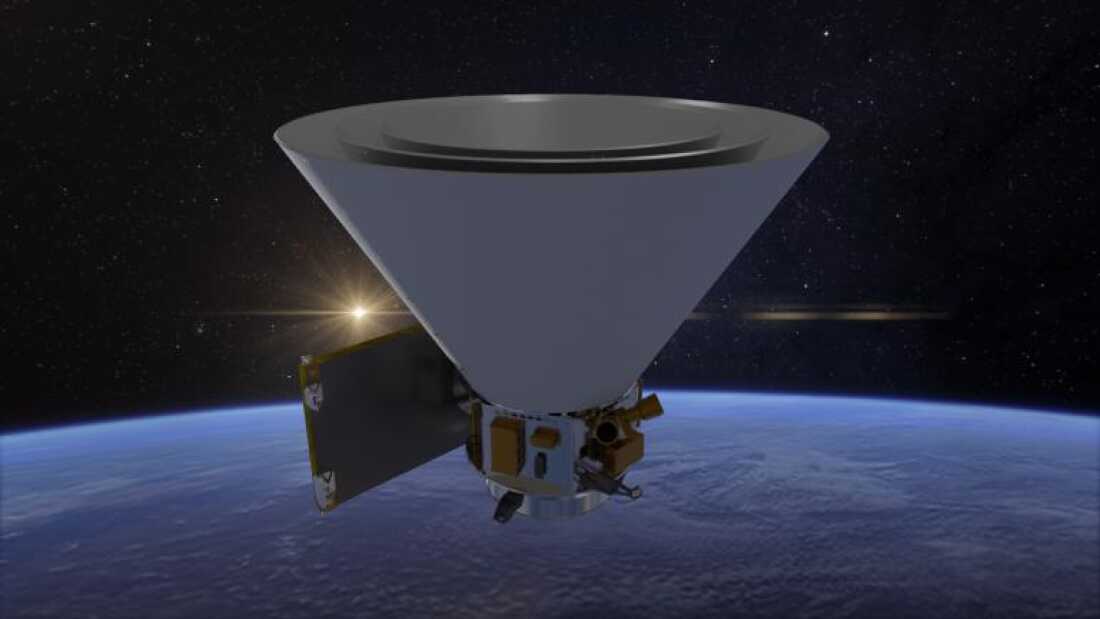- Courses
- GS Full Course 1 Year
- GS Full Course 2 Year
- GS Full Course 3 Year
- GS Full Course Till Selection
- Answer Alpha: Mains 2025 Mentorship
- MEP (Mains Enrichment Programme) Data, Facts
- Essay Target – 150+ Marks
- Online Program
- GS Recorded Course
- Polity
- Geography
- Economy
- Ancient, Medieval and Art & Culture AMAC
- Modern India, Post Independence & World History
- Environment
- Governance
- Science & Technology
- International Relations and Internal Security
- Disaster Management
- Ethics
- NCERT Current Affairs
- Indian Society and Social Issue
- NCERT- Science and Technology
- NCERT - Geography
- NCERT - Ancient History
- NCERT- World History
- NCERT Modern History
- CSAT
- 5 LAYERED ARJUNA Mentorship
- Public Administration Optional
- ABOUT US
- OUR TOPPERS
- TEST SERIES
- FREE STUDY MATERIAL
- VIDEOS
- CONTACT US
NASA Set to Launch SPHEREx Telescope to Explore the Universe's Origins
NASA Set to Launch SPHEREx Telescope to Explore the Universe's Origins

- NASA is preparing to launch a new telescope, SPHEREx (Spectro-Photometer for the History of the Universe, Epoch of Reionisation, and Ices Explorer) to explore the beginnings of the universe and search for water in the Milky Way.
- Location: Sun-synchronous Low Earth Orbit.
- Mission is Planned for 7 march 2025, aboard a SpaceX Falcon 9 rocket from Vandenberg Space Force Base.
- Duration: The mission will last 2 years and it will study over 450 million galaxies and 100 million stars.
- Key Instruments: SPHEREx will take images in every direction, splitting light from cosmic sources (like stars and galaxies) into wavelengths to study their composition and distance.
SPHEREx’s Contribution to Science:
|
Main Goals of the SPHEREx Mission:
- SPHEREx will study cosmic inflation, the rapid expansion of the universe immediately after the Big Bang.
|
The Big Bang is the scientific theory that explains how the universe began. It suggests that about 13.8 billion years ago, the universe started from a single point, which was incredibly hot and dense. This point then rapidly expanded, causing the universe to grow and cool down over time, leading to the formation of stars, galaxies, and everything we see today. |
- Cosmic inflation is a theory that explains the very early stages of the universe's expansion, just after the Big Bang.
- Cosmic Inflation explains how the universe grew from a tiny point to its current size after the Big Bang. This idea suggests the universe expanded by a trillion-trillion-fold in a very short time.
- The exact cause of inflation is still uncertain, and SPHEREx will help to gather information to understand it better.
- The telescope will create a 3D map of the universe, showing the distribution of galaxies across the sky.
- It will capture images in 102 colors (different wavelengths of light) to give a detailed view of the universe’s structure.
- SPHEREx will study interstellar dust grains in molecular clouds, where new stars and planets are formed.
- These dust grains may hold frozen water molecules and other important molecules like carbon dioxide and carbon monoxide.
- Finding water in these clouds is key to understanding where life-supporting water comes from.
NASA’s PUNCH Mission (Alongside SPHEREx):
|
Other Key Space Telescopes and Missions:
Aditya-L1: India’s First Solar Observatory
Aditya-L1 is India's first solar observatory, launched in September 2023. Its mission is to study the Sun's outer layers, including the chromosphere, photosphere, and corona. The goal is to understand solar activities and their impact on space weather.
What does Aditya-L1 do?
- Studies the dynamics of the Sun's upper atmosphere.
- Studies the physics of partially ionized plasma.
- Investigates the initiation of coronal mass ejections and solar flares.
- Studies the particle and plasma environment around the Sun.
- Measures the magnetic field topology in the solar corona.
- Identifies the drivers of space weather.
Where is Aditya-L1?
- Aditya-L1 is located at the L1 Lagrange point, which is positioned between the Earth and the Sun.
- The L1 point is about 1.5 million kilometers away from Earth.
- Aditya-L1 takes 178 days to complete one revolution around the L1 point.
What has Aditya-L1 observed?
- Aditya-L1 captured the first-ever image of a solar flare 'kernel' in the lower solar atmosphere.
- It has observed a Coronal Mass Ejection (CME), which is a massive burst of solar plasma and magnetic fields.
|
What is A Lagrange point ? A Lagrange point is a position in space where the gravitational forces of two large celestial bodies, like the Earth and the Sun, balance out the centrifugal force felt by a smaller object. This balance allows the smaller object to stay in a stable position relative to the two larger bodies.
There are five Lagrange points (L1 to L5) in the Earth-Sun system, each with unique properties:
Lagrange points are useful for placing satellites and space telescopes because of their stable orbits, reducing the need for constant adjustments. |
Hubble Space Telescope (HST)
The Hubble Space Telescope (HST) was launched into space on April 24, 1990, by the Space Shuttle Discovery.
What was the Hubble Space Telescope's purpose?
- The HST was NASA's first Great Observatory.
- It was the first telescope that could be visited and repaired by astronauts in space.
- It was designed to observe planets, stars, black holes, and other astronomical phenomena.
What has the Hubble Space Telescope accomplished?
- It has helped determine the age of the universe.
- It has observed changes in celestial bodies in our solar system.
- It has expanded our understanding of star birth and death.
- It has helped transition black holes from scientific theory to fact.
What are some of the images taken by Hubble?
- The Helix Nebula
- R136
- The Crab Nebula
- Shoemaker-Levy 9 fragment G
- NGC 6891
- Saturn and its moons
James Webb Space Telescope (JWST)
- The James Webb Space Telescope (JWST) is a space observatory that studies the universe in infrared light. It is the most powerful space telescope ever built.
- Launched on December 25, 2021
- Located at the 2nd Lagrange point, 1.5 million kilometers from Earth
- An international collaboration between NASA, ESA, and CSA
What does JWST do?
- Studies the formation of the first galaxies and stars.
- Examines the formation of planetary systems, including our own solar system.
- Looks for signs of life in planetary systems.
- Studies the evolution of galaxies over time.
- Studies the stages of star formation.
How does JWST work?
- JWST's infrared cameras can see through dust clouds.
- Its longer wavelength coverage allows it to see further back in time than the Hubble Space Telescope
Orbit Types and Uses
|
Orbit Type |
Altitude Range |
Uses |
Explanation |
|
Sun-Synchronous Orbit |
600 km to 800 km (in LEO) |
Earth observation, weather satellites |
The satellite stays in sync with the Sun, meaning it passes over the same place at the same time each day. This is useful for observing the Earth's surface under consistent lighting conditions. |
|
Low Earth Orbit (LEO) |
160 km to 2,000 km |
Space stations, Earth observation, satellites |
Satellites in LEO are closest to Earth and take about 90 minutes to orbit. They are commonly used for space stations like the ISS and for observing Earth's surface. |
|
Geostationary Orbit (GEO) |
35,786 km above Earth’s equator |
Weather, communication, broadcasting |
A satellite in GEO stays above the same spot on Earth because it orbits at the same speed the Earth rotates. This orbit is used for weather satellites and communication. |
|
Medium Earth Orbit (MEO) |
2,000 km to 35,786 km |
GPS satellites, navigation systems |
MEO is used for navigation satellites like GPS. These satellites orbit higher than LEO but not as high as GEO, providing global positioning information. |
|
Polar Orbit |
160 km to 2,000 km |
Earth observation, climate monitoring |
Satellites in polar orbits pass over the Earth’s poles, which allows them to scan the whole planet as Earth rotates. This orbit is ideal for environmental and weather monitoring. |
|
Highly Elliptical Orbit (HEO) |
Varies, between LEO and GEO |
Polar region observation, high-latitude communication |
The orbit is oval-shaped, and the satellite stays longer over certain regions (like the poles). It’s used for communication or observation in high-latitude areas. |
|
Geosynchronous Orbit (GSO) |
35,786 km |
Similar to GEO, but with slightly elliptical orbits |
Like GEO, but with a slightly tilted or elliptical orbit. It’s used for similar purposes, but the satellite may move a little over time instead of staying fixed in one spot. |
|
Also Read |
|
| NCERT Books For UPSC | |
| UPSC Monthly Magazine | Best IAS Coaching in Delhi |




